Remembering Urbie Green
Remembering Urbie Green
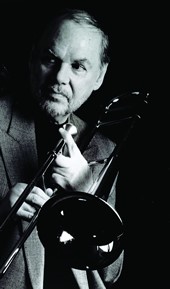 Rest in peace, Urbie Green, legendary trombonist and Local 802 member since 1954. Urbie passed away on December 31, 2018 at the age of 92.
Rest in peace, Urbie Green, legendary trombonist and Local 802 member since 1954. Urbie passed away on December 31, 2018 at the age of 92.
“Listen to all kinds of music, for one thing. Practice a lot. Listen to people who have made a success out of it. Listen to everybody you can, especially people who are successful to a degree and practice regularly. If you’re a jazz player, put together jam sessions with those who have like minds about it and play as often as you can. Go through all your books, too, scales and such. Be nice.”
-Urbie Green, speaking in a 2014 Allegro interview. Read it here.
Below, Local 802 musicians remember Urbie’s life and legacy in their own words.
Joseph Alessi, Principal Trombone at the New York Philharmonic

Urbie Green on the cover of the June 2014 Allegro.
I was deeply saddened to learn of the passing of one of my heroes, Urbie Green, who was undoubtedly one of the greatest trombonists who has ever graced the planet. My heart goes out to his whole family at this difficult time. I am very fortunate to have many, if not all, the recordings Urbie has ever made. It is comforting to listen to Urbie’s genius on any day of week but especially at this sad moment. A couple of my all-time favorites are “At Last,” “Slide Work in Ab” with the Urbie Green Sextet, and “I Gotta Right to Sing the Blues” from the 21 Trombones LP, which are tracks on just a few albums among his huge discography. Urbie’s tone, style, phrasing, range, and facility are incomparable. His work is so exceptional that when my students at Juilliard want to improve their high register it is a requirement that they must listen and study Urbie Green to hear the master at work. These recordings are vitally important; it is up to us to share our knowledge of the great musicians in history who have helped shape the future of our instrument.
Several years ago, I mustered the courage to call Urbie and offered to take him and his beautiful wife Kathy out to lunch. I have many photos from this wonderful day and I cherish the time we spent together. There are two other occasions when I met up with Urbie: the first was when I presented him with the International Trombone Association President’s Award. Later that year, when we hosted the International Trombone Festival at the Juilliard School, we found the perfect event to honor Urbie in ways he richly deserved surrounded by many who loved his playing and so much else about him. We can talk endlessly about his playing and his genius, but I want everyone to know that Urbie was, above all else, a great human being. He was kind, gentle, and soft-spoken, and he exemplified the fact that the truly great people in history, those who are great in the ways that really matter are often humble and kind. I salute Urbie now and forever. There will never be another Urbie Green….
Paul Faulise, Legendary Studio Bass Trombonist (formerly of Frank Sinatra’s band)
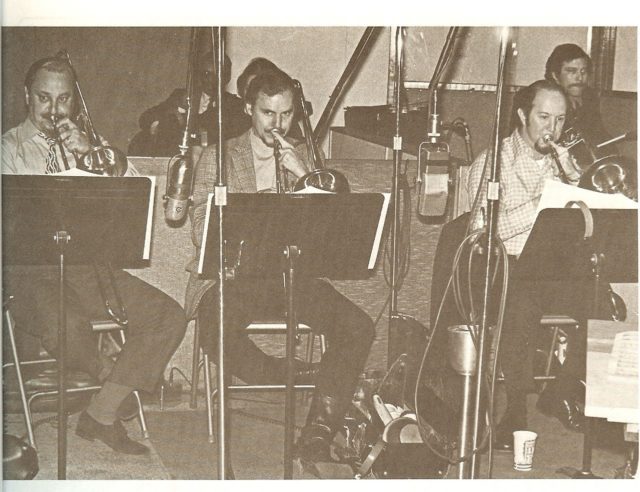
Buddy Morrow, Urbie Green, and Paul Faulise. Photo courtesy of Jack Schatz.
The first time I met Urbie Green and heard him play was in 1954 when Urbie was the lead trombonist in Woody Herman’s Thundering Herd. The band came to Buffalo where I grew up and gave a concert. I went to hear the band play. At that time, I was playing tenor and bass trombone. I was in awe of Urbie’s playing. He had a sound like no other trombone player I had ever heard before, and he couldn’t have been nicer. After hearing Urbie play I made sure I bought every new Woody Herman recording that had Urbie on it. After a stint in the Army, I moved to New York City in hopes of breaking in to the scene there. Slowly but surely, I broke into the recording field. My first recordings were jazz sessions with Ernie Wilkins, and then commercial work. My first recording with Urbie was for Claus Ogerman. The date was for three brass: Doc Severinson, Urbie, and myself. I subsequently started working with Urbie quite a bit and was honored when he asked me to join his big band. Every time I worked with Urbie, it was like taking a lesson. I paid very close attention to all of his nuances, vibrato, and style. Urbie and I recorded together so often that we became very close friends and saw one another socially as well. Urbie and I were fortunate to do three world tours together with the Phillip Morris Super Band in the early 1990’s. Doing a recording date with Urbie was like seeing the sun come up. You knew with Urbie there, it was going to be a wonderful session. My friend Urbie was a soft-spoken, gentle man of few words. When he played the trombone, he spoke volumes. There will never be another Urbie. He was in a class by himself.
Keith O’Quinn, Lead Trombonist with Bob Mintzer and Maria Schneider bands.
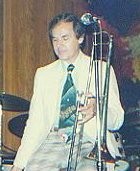
Urbie Green
I grew up in a small town in Southwest Missouri. There wasn’t much to do there culturally, and our lives as young kids mostly centered around school, family, church, and friends. At our school we were very lucky to have a young, enthusiastic band director who put together a very good music department that encompassed the entire school district from elementary thru high school. I discovered a love for the trombone at age 11, and at 13 heard Urbie for the first time on a record entitled “The Persuasive Trombone of Urbie Green.” I could not believe that the trombone could be played that way! The sound, the style, the complete ease with which he played seemingly impossible phrases all over the horn was enough to make your head explode. Then a couple of years later, “21 Trombones” came out and I think it changed the lives of trombone players forever. Urbie said he had a vivid dream one night about 21 trombones playing together and he knew he had to make that record. They kept trying to get him to do it with 5 or 10 trombones but he insisted it had to be 21, because that was what he had dreamt. Thankfully, he got his way.
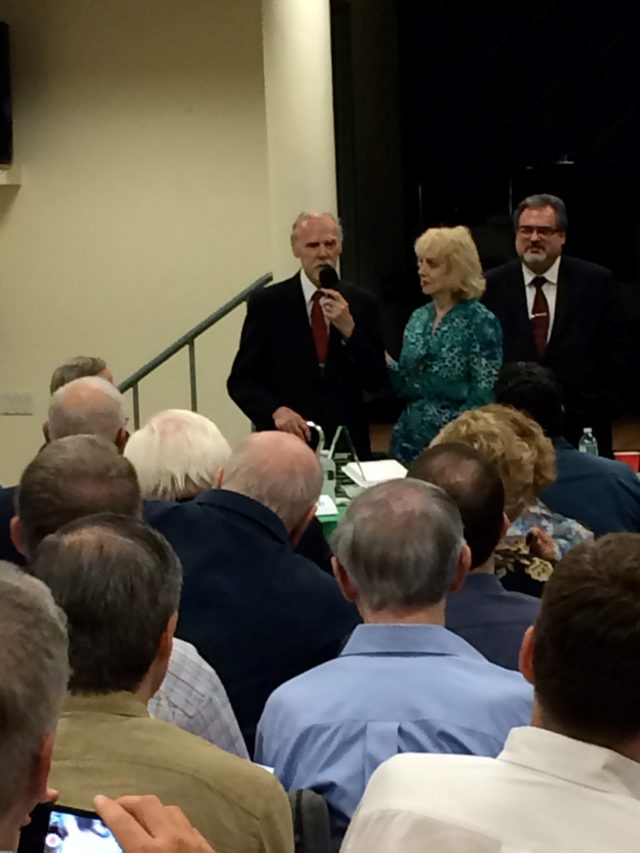
Urbie Green honored at Local 802 in 2014.
Around 1968, Urbie was going to be the featured soloist with the Southwest Missouri State College band in Springfield, about an hour from our town. Our band director organized a trip for our band to see the concert. It was in a basketball auditorium with chairs set up on the floor and it was quite crowded. We had seats pretty close to the front. Urbie played magnificently. Flawless and beautiful. In those days he had a chart on Flight of the Bumblebee titled “The Green Bee,” which he would play on clinics and concerts. It was a Batman-ish, sixty’s rock chart and a big crowd pleaser which showed off Urbie’s amazing technique. When they played it in the concert, Urbie was flying through the tune when suddenly his slide went airborne and bounced across the floor, ending up several rows back under a chair. He stood there in disbelief and his face turned bright red as a lady from the audience brought the slide up to him. He made some funny comments over the mic and, after checking to see if the slide would still move, started the tune over and finished the concert beautifully. I’m sure the slide was damaged, but you would never have known it.
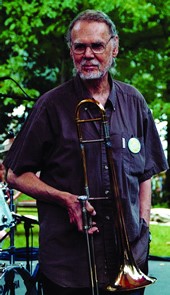
Urbie Green
After I moved to New York and began working more steadily I started to get called for studio work and was thrilled to be on gigs with so many of the great trombone players that I had listened to on records over the years and who were idols to me. It was especially thrilling to be in a section with Urbie. I was always awestruck around him, and always nervous, but Urbie was a beautiful, gentle person who always put you at ease and made you feel comfortable and welcome. On the occasions I had the honor to play with him I never brought up the concert I had been to, but one day on a jingle date, as we were packing up, I decided to mention it to him. I said, “Urbie, when I was in high school, I got to see you in a concert in Springfield, Missouri,” and before I could say another word he started laughing and turned that same shade of red and said, “Oh no, you were there?” He told me that had never happened to him before and he remembered it in horror like it was yesterday. For me, it was one of the greatest, most inspiring concerts I’ve ever attended.
I wish that I had had more opportunities to work with Urbie and to know him better, but the times I did have were so special to me. I feel so lucky to have even breathed the same air that he was breathing. He was the best there was, a giant of the trombone but also such a kind, humble man. Everyone adored him. There will never be another Urbie Green. The world is missing a beautiful voice and trombonists everywhere will forever celebrate him. Thank you, Urbie, and rest in peace.
Alan Raph, Legendary Studio Bass Trombonist
When Urbie started working in the NYC studios in the 50’s he quickly became the ‘first call’ for almost every leader. At one point, Urbie, Bobby Byrne, and Frank Rehak all chipped in and bought a piper cub (airplane). Chauncy Welsch commented, “…and Frank Saracco bought an anti-aircraft gun.”
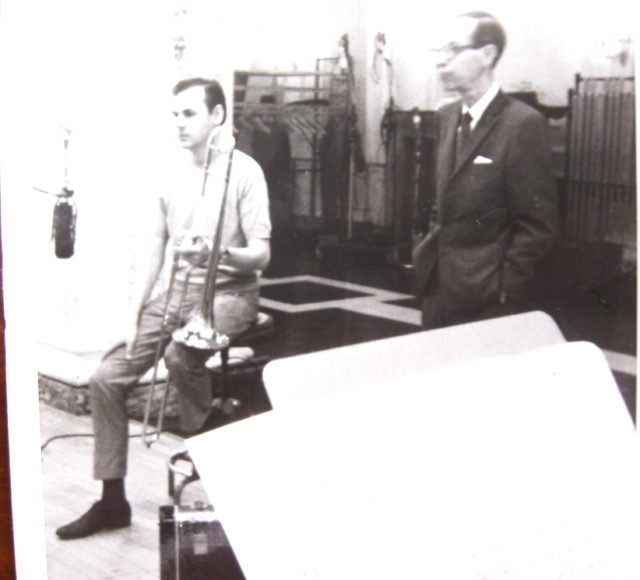
Urbie Green with arranger Lew Davies at the 21 Trombones recording session at Fine Sound studio, 9/25/67. Photo by Alan Raph.
I remember moving from the Tommy Dorsey-as-idol camp into the Buddy Morrow-as-something-else-circle and one day while I was visiting Larry O’Brien, he played some of Urbie’s recordings. Right then I thought very seriously about concentrating on bass trombone (as did George Roberts under similar circumstances.)
In 1967, Urbie was 41 years old and he recorded album #1 of the two “Twenty-One Trombones” albums. Earlier that year a company called “Craig” came out with a small battery-powered portable reel to reel tape recorder in contrast to the large tape recorders of the day. It had a built-in microphone and a fairly decent tone quality. These became popular: easy to carry and easy to use. The 3½ inch reels revolved at 1.87 inches per second. I had bought one some time prior to the trombone sessions and brought it into the studio. As luck had it, we recorded “Stardust” and Urbie made several takes of the (now) famous cadenza. He was meticulous about his renditions and we spent between 10 and 15 minutes getting it ‘just right.’ I recorded all of the ‘takes’… a few false starts, a few small glitches… but basically ‘on the money.’ All together there were 12 passes. Today we all know the finished product…well worth the care and trouble. I admired Urbie’s self-control under those demanding conditions and I still marvel at the fact that he had such a grasp on the cadenza in the first place. He was like that in every musical situation through the years. Totally in command and focused. I worked with Urbie during the 60’s and 70’s almost on a daily basis. It was always the high point of my day.
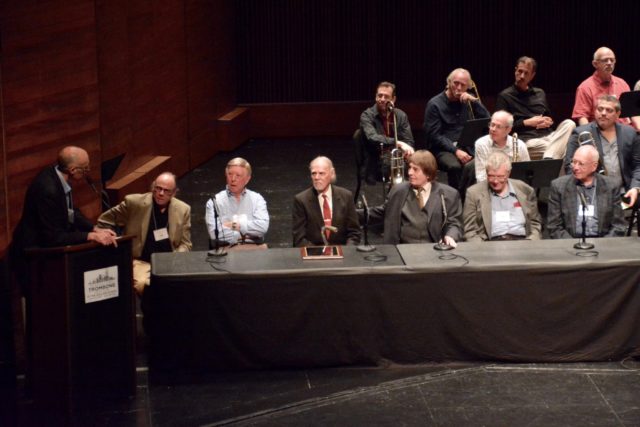
Urbie Green honored at the International Trombone Festival in 2016. Photo courtesy of Jack Schatz.
Often when I compare myself to others, age is a criteria. In retrospect, I noticed that there were seven-year spans between some notable trombonists. I was born in 1933. Urbie…seven years before. Buddy Morrow, another seven years, Will Bradley, again seven years (1912). Tommy Dorsey (1905), Miff Mole (1898), and even Emory Remington (1891). Going the other way Bill Watrous broke the sequence (6 years).
I last saw Urbie at the ITA conference in 2016 at Juilliard. He didn’t have an easy time in his final years…he should have.
Jack Schatz, Freelance Trombonist and Faculty at Purchase College
Urbie Green was the trombonist that everyone emulated and was inspired by. He was a member of Local 802 since 1954. He was one of the true greats of jazz and among the elite of the world’s players. No one played with a smoother, warmer sound. He was born and raised in Mobile, Alabama, and was working with Tommy Reynolds’ band by the time he was 16. He then played with the bands of Jan Savitt, Frankie Carle, and Gene Krupa. In 1950, Urbie joined Woody Herman’s Thundering Herd and in 1954 was awarded the Downbeat International Critics Award.
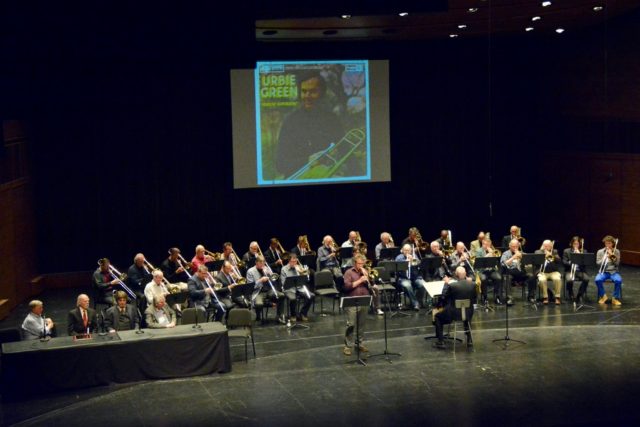
Urbie Green honored at the International Trombone Festival in 2016. Photo courtesy of Jack Schatz.
Urbie became one of the most sought-after trombonists for recording and club work in New York City. He was a multiple winner of the Most Valuable Player Award from the National Academy of Recording Arts and Sciences, and perhaps the most recorded trombonist of all time. He recorded with Gene Krupa, Woody Herman, Benny Goodman, Louis Armstrong, Count Basie, Leonard Bernstein, Frank Sinatra, Billie Holiday, Tony Bennett, and many others. Urbie played at major jazz festivals worldwide, films, concert halls, nightclubs, radio, and television, and the White House. Urbie was in a class all by himself. Urbie also recorded albums as a leader but none cemented his reputation as a true leader than Let’s Face The Music and Dance in 1958. In 1960 he recorded The Persuasive Trombone of Urbie Green Volumes One and Two and in 1967 he assembled twenty of New York’s best trombone players and recorded his famous 21 Trombones recordings. Urbie was honored at Local 802 in 2014, and at the International Trombone Festival in 2016.
Steve Wallace, Jazz Bassist based in Toronto
Urbie Green was put on this earth to play the trombone perfectly, which he did for decades. He was also a lovely man: modest and humble despite his accomplishments, very shy and retiring. I had the privilege of playing with him for several weeks in Toronto jazz clubs when I was quite young. Urbie took me under his wing, teaching me some valuable specific things about chord changes and talking music and musicians in his own quiet way. Trying to rise to his level forced me to up my game and I’ll always be grateful for having known him even briefly. Rest in peace, Urbie.
Listen to some of Urbie Green’s greatest musical achievements:
Urbie Green’s 21 Trombones: “Here’s That Rainy Day”
The Persuasive Trombone of Urbie Green: “At Last”
Urbie Green: “Let’s Face the Music and Dance”
Urbie Green’s Big Beautiful Band
(Links courtesy of Jack Schatz and Bill Kirchner)
Have a reminiscence about Urbie you’d like to share? Contact Maria DiPasquale.
